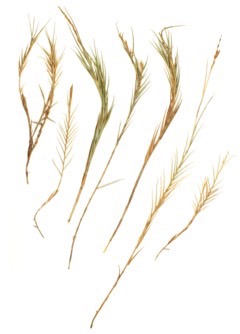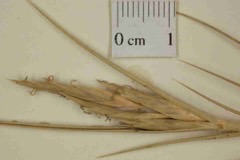 |
|
University of Arizona Herbarium |
 |
| University of Arizona Herbarium |
Translate this page:
Summary
Physical Characteristics

 Distichlis palmeri is a PERENNIAL growing to 0.4 m (1ft 4in) by 0.2 m (0ft 8in) at a fast rate.
Distichlis palmeri is a PERENNIAL growing to 0.4 m (1ft 4in) by 0.2 m (0ft 8in) at a fast rate.
See above for USDA hardiness. It is hardy to UK zone 10.
Suitable for: light (sandy), medium (loamy) and heavy (clay) soils. Suitable pH: neutral and basic (mildly alkaline) soils and can grow in very alkaline and saline soils.
It can grow in semi-shade (light woodland) or no shade. It prefers moist or wet soil and can grow in water and can tolerate drought.
UK Hardiness Map
US Hardiness Map
Synonyms
Uniola palmeri Vasey
Plant Habitats
Edible Uses
Edible Parts: Seed
Edible Uses:
Edible Portion: Seeds, Cereal. Originally a major food source of the Cocopah tribe in the western United States. The grains are cooked as a cereal. They are roasted or used in muffins or stuffings. Carbon Farming Solutions - Staple Crop: balanced carb (The term staple crop typically refers to a food that is eaten routinely and accounts for a dominant part of people's diets in a particular region of the world) [1-1]. A deep root system reaches down at least 1.5m. It is ideally suited to areas saline discharge zones, where it can readily access the saline water, and dry out the soil profile, while producing a valuable grain. The grain that is produced is ideally suited for human consumption, with an amino acid balance that is more favorable than wheat, and it is also gluten free and has a pleasant nutty flavor. Work with the grain in Australia has shown it to have a higher yield of flour to grain that wheat, it's starch rapidly retrogrades an behaves as an emulsifier. The United Nations Environment Report (2006) says of the plant: "It is a strong candidate for a major global food crop and could become this desert's greatest gift to the world." Some varieties of D. palmeri have been the subjects of US patents.
References More on Edible Uses
Medicinal Uses
Plants For A Future can not take any responsibility for any adverse effects from the use of plants. Always seek advice from a professional before using a plant medicinally.
None Known
References More on Medicinal Uses
The Bookshop: Edible Plant Books
Our Latest books on Perennial Plants For Food Forests and Permaculture Gardens in paperback or digital formats.

Edible Tropical Plants
Food Forest Plants for Hotter Conditions: 250+ Plants For Tropical Food Forests & Permaculture Gardens.
More

Edible Temperate Plants
Plants for Your Food Forest: 500 Plants for Temperate Food Forests & Permaculture Gardens.
More

More Books
PFAF have eight books available in paperback and digital formats. Browse the shop for more information.
Shop Now
Other Uses
Fodder
Saltgrass is grazed by both cattle and horses and it has a forage value of fair to good because it remains green when most other grasses are dry during the drought periods and it is resistant to grazing and trampling.
Special Uses
Carbon Farming Food Forest
References More on Other Uses
Cultivation details
Management: Fodder Management: Standard Staple Crop: Balanced carb Wild Staple Crop
Climate: tropical. Humidity: humid, aquatic. Grows along coastlines and on salt flats and disturbed soils, as well as forest, woodland, montane, and desert scrub habitats. Grows easily in salty and alkaline soils, excreting salts from its tissues via salt glands. It is drought resistant and can absorb seawater. As a halophyte, the salt it absorbs is excreted from specialised cells on the leaf surface. A breeding program in the US has increased yields to 2 tonnes/ha. Carbon Farming Solutions - Cultivation: wild staple, under development. Management: standard, fodder (Describes the non-destructive management systems that are used in cultivation) [1-1].
Carbon Farming
-
Management: Fodder
Non-destructive management systems maintaining the soil organic carbon.
-
Management: Standard
Plants grow to their standard height. Harvest fruit, seeds, or other products. Non-Destructive management systems.
-
Staple Crop: Balanced carb
(0-15 percent protein, 0-15 percent oil, with at least one over 5 percent). The carbohydrates are from either starch or sugar. Annuals include maize, wheat, rice, and potato. Perennials include chestnuts, carob, perennial fruits, nuts, cereals, pseudocereals, woody pods, and acorns.
-
Wild Staple Crop
Some wild plants have strong historical or contemporary use. Although they are not cultivated crops, they may be wild-managed.
References Carbon Farming Information and Carbon Sequestration Information
Temperature Converter
Type a value in the Celsius field to convert the value to Fahrenheit:
Fahrenheit:
The PFAF Bookshop
Plants For A Future have a number of books available in paperback and digital form. Book titles include Edible Plants, Edible Perennials, Edible Trees,Edible Shrubs, Woodland Gardening, and Temperate Food Forest Plants. Our new book is Food Forest Plants For Hotter Conditions (Tropical and Sub-Tropical).
Shop Now
Plant Propagation
Seed
Other Names
If available other names are mentioned here
Nyipa, Trigo gentil, Wild-wheat, Palmer's grass, Nipa grass, Saltgrass
Native Range
NORTHERN AMERICA: Mexico (Baja California (Norte), Sonora)
Weed Potential
Right plant wrong place. We are currently updating this section.
Please note that a plant may be invasive in one area but may not in your area so it's worth checking.
None Known
Conservation Status
IUCN Red List of Threatened Plants Status : This taxon has not yet been assessed

Growth: S = slow M = medium F = fast. Soil: L = light (sandy) M = medium H = heavy (clay). pH: A = acid N = neutral B = basic (alkaline). Shade: F = full shade S = semi-shade N = no shade. Moisture: D = dry M = Moist We = wet Wa = water.
Now available:
Food Forest Plants for Mediterranean Conditions
350+ Perennial Plants For Mediterranean and Drier Food Forests and Permaculture Gardens.
[Paperback and eBook]
This is the third in Plants For A Future's series of plant guides for food forests tailored to
specific climate zones. Following volumes on temperate and tropical ecosystems, this book focuses
on species suited to Mediterranean conditions—regions with hot, dry summers and cool, wet winters,
often facing the added challenge of climate change.
Read More
Expert comment
Author
(Vasey) Fassett ex I. M. Johnst
Botanical References
Links / References
For a list of references used on this page please go here
Readers comment
| Add a comment |
|
If you have important information about this plant that may help other users please add a comment or link below. Only comments or links that are felt to be directly relevant to a plant will be included. If you think a comment/link or information contained on this page is inaccurate or misleading we would welcome your feedback at [email protected]. If you have questions about a plant please use the Forum on this website as we do not have the resources to answer questions ourselves.
* Please note: the comments by website users are not necessarily those held by PFAF and may give misleading or inaccurate information.
To leave a comment please Register or login here All comments need to be approved so will not appear immediately.
|
Subject : Distichlis palmeri
|
|
|
|